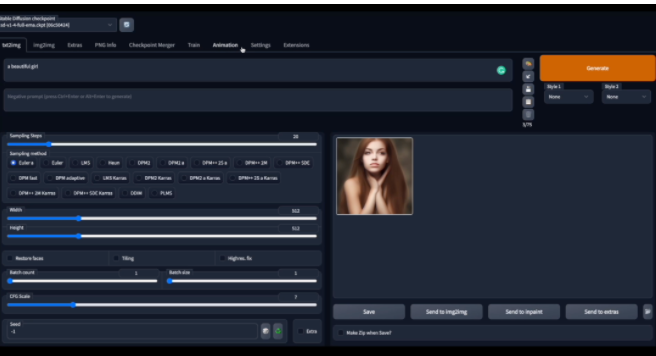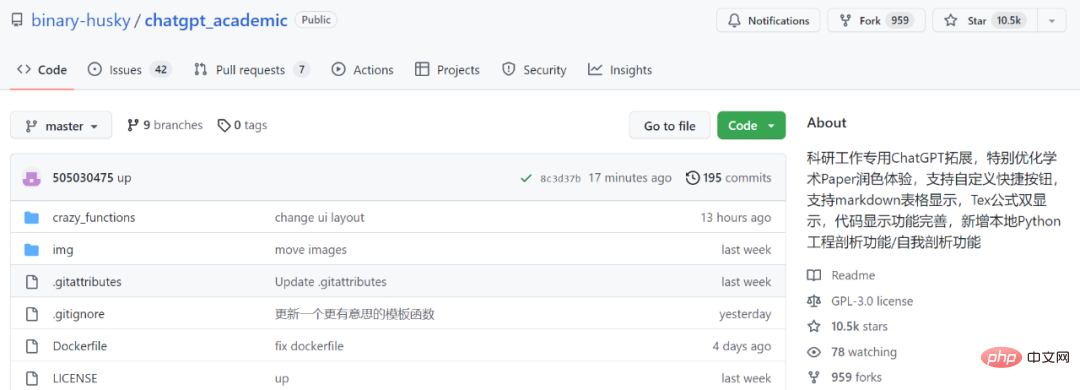 Technology peripherals
Technology peripherals AI
AI Supporting ChatGPT, Huang Renxun's ten-year bet on AI has yielded huge returns
Supporting ChatGPT, Huang Renxun's ten-year bet on AI has yielded huge returns
News on March 8, for about the past 25 years, NVIDIA has always led the revolution in the field of computer graphics, occupying the largest share of the graphics processing unit (GPU) market. has established a dominant position and become a brand loved by gamers. Despite its recent decline, the gaming business still brought in more than $9 billion in revenue for Nvidia last year.
Nvidia’s latest financial report shows new signs of growth in the graphics processor business, as this technology has now become the core of the AI boom. Last month, Nvidia CEO Jensen Huang said: "We very smartly changed the company's strategy. About a decade ago, we saw that this way of doing software could change everything. We changed the company from the bottom up. Elevate to the top and then develop horizontally. Every chip we make is focused on AI."
As the engine behind large language models (LLM) such as the recently popular chatbot ChatGPT, NVIDIA It's finally reaping returns on its early investments in AI, helping to cushion Nvidia from the semiconductor industry's woes. "We redesigned all of our products to be compliant with regulations while still being able to serve our commercial customers," Huang said. "We are able to provide regulated parts to our customers and are happy to support them."
NVIDIA plans to hold the company’s annual GTC developer conference from March 20 to 23, and AI is expected to be the focus of the event. Previously, Huang Jensen talked about the company's central role in the rise of AI-generated content (AIGC). When asked whether Nvidia's generous returns were luck or foresight, Huang said: "We just firmly believe that one day something new will happen, and the rest will require some serendipitous discoveries."
Graphics Processors are Nvidia's main business, accounting for more than 80% of the company's revenue. They are often sold as the brains of graphics cards and can also add computing power to central processing units (CPUs) made by companies such as AMD and Intel. Now, tech companies competing with ChatGPT are openly touting how many Nvidia A100s they own, a chip worth about $10,000 that has become one of the AI industry's most critical tools. Microsoft said that the supercomputer developed for OpenAI uses 10,000 Nvidia A100s.
Vivek Arya, semiconductor analyst at Bank of America Securities, said: “It’s very easy to use Nvidia’s products and add computing power. At present, computing power is basically equivalent to hard currency in Silicon Valley. ”
Huang Renxun demonstrated NVIDIA’s next-generation system H100, which has begun shipping. H stands for Hopper. He said: "What's really amazing about Hopper is this new processing technology called Transformer Engine. Transformer Engine stands for the T in GPT (Generative Pre-trained Transformer). This is The world's first computer designed to handle large-scale converters. Therefore, large-scale language models will be faster and more cost-effective."
Huang Renxun said that he personally delivered it to ChatGPT developer OpenAI The world's first AI supercomputer.
Not afraid to put everything on the line
Today, NVIDIA is one of the top ten technology companies with the highest market value in the world, with a market value of nearly $600 billion. The company has 26,000 employees and has a new polygon-themed headquarters. Nvidia is also one of the few Silicon Valley giants that is still helmed by its founder for 30 years.
Huang, 60, immigrated to the United States as a child and studied engineering at Oregon State University and Stanford University. In the early 1990s, Huang met with engineers Chris Malachowsky and Curtis Priem at a Denny's restaurant to discuss making personal computers capable of 3D graphics. dream.
In 1993, the three founded Nvidia in an apartment in Fremont, California. The name is inspired by NV (next version) and Invidia, which means envy in Latin. They wanted to increase their computing speed and make everyone feel envious, so they chose the green eyes that represent envy as the company's logo.
Arria, a semiconductor analyst at Bank of America Securities, said: "Nvidia was one of dozens of GPU manufacturers at the time, and they were the only company that really survived because Nvidia worked very well with the software community and developers. Good."
Huang Jen-Hsun's ambition and penchant for taking risks that seemed unlikely to succeed have pushed Nvidia to the brink of bankruptcy several times. "Every company makes mistakes, and I made a lot of them," he admits. "Some of them even put the company in danger, especially in the beginning, because we were so small and we were dealing with so many behemoths. We can only work hard to develop completely new technologies.”
For example, around 2010, NVIDIA entered the smartphone field with its Tegra series processors, but was unsuccessful. The company then exited the market entirely. Also in 1999, after laying off most of its employees, Nvidia released what was said to be the world's first official graphics processor, the GeForce 256. It was the first programmable graphics card to allow customization of shadows and lighting effects. By 2000, Nvidia had become Microsoft's exclusive graphics chip supplier for the first Xbox. In 2006, the company made another big bet and released a software toolkit called CUDA.
Bryan Catanzaro, vice president of applied deep learning research at Nvidia, said: "For 10 years, Wall Street has been asking Nvidia: 'Why are you making this investment? No one is using it. .’ At our market cap, it was valued at zero.” When Catanzaro joined Nvidia in 2008, he was one of the few employees working on AI research. Today, the company has thousands of employees working in this field.
Catanzaro said: "It wasn't until around 2016, 10 years after CUDA came out, that people suddenly realized that this was a completely different way of writing computer programs. It had transformative acceleration capabilities. , and then achieve breakthrough results in the field of AI."
Despite the rapid development of the AI business, games are still Nvidia's main business. In 2018, the company used its AI expertise to make the next big leap in graphics. Based on the experience learned in the field of AI, NVIDIA launched GeForce RTX.
Jen-Hsun Huang said: "To take computer graphics and video games to the next level, we have to reinvent technology and disrupt ourselves, completely changing what we invent. We invented this new way of doing computer graphics , ray tracing, basically simulates the path of light and simulates everything with generative AI. So we count one pixel and then use AI to imagine seven other pixels."
"Boom-Bust Cycle ”
From the beginning, Huang Renxun has been committed to building Nvidia into a factory-less chip company, that is, focusing on product design and outsourcing production to other companies with chip processing plants. By outsourcing chip manufacturing to TSMC, Nvidia has reduced capital expenditures. TSMC said it will spend $40 billion to build two new chip manufacturing plants in Arizona. Huang promised that Nvidia would use TSMC's Arizona factory to make chips. Then there's the question about demand and how many new GPU use cases will continue to drive growth. When cryptocurrency mining took off, demand for Nvidia surged as GPUs became central to effectively competing in this market. Nvidia has even created a stripped-down version of its graphics processor just for cryptocurrency mining. But as the cryptocurrency market collapsed, Nvidia experienced a supply and demand imbalance.
Aria, a semiconductor analyst at Bank of America Securities, said: "This creates a big problem for Nvidia because cryptocurrency mining has been in a boom-bust cycle. Gaming graphics cards are out of stock and prices are jacked up. Then when the cryptocurrency mining craze collapses, gaming graphics cards will also collapse dramatically."
Last year, Nvidia's new 40 series GPUs were priced much higher than the previous generation and were criticized by some gamers. Now due to oversupply, Nvidia's gaming business revenue fell 46% in the latest quarter compared with the same period last year.
Competition is intensifying as technology giants such as Tesla, Apple, Google and Amazon increasingly design their own custom chips. "The big question for Nvidia is how do they stay ahead of the curve? Their customers could also become their competitors," Arria said. "Microsoft could try to design these things in-house, and Amazon and Google already design their chips in-house." ”
But for Huang Renxun, the advantages of such competition outweigh the disadvantages. He said: "Global data center power demand is going to grow, and it's a big problem for the world. The first thing we should do is: every data center in the world, no matter what you decide to do, for Maintain the benefits of sustainable computing and accelerate wherever you can."
In the automotive market, Nvidia is developing self-driving technology for Mercedes-Benz and other companies. Its systems are also used to power robots in Amazon warehouses and run simulations through the Omniverse platform to optimize the delivery of millions of packages every day.
Huang Renxun said: "We now have more than 700 customers trying Omniverse, from the automotive industry to logistics warehouses to wind turbine factories. It probably represents the largest container of all NVIDIA technologies: computer graphics, AI , robotics and physics simulation, all in one. I have high hopes for it." (Xiao Xiao)
The above is the detailed content of Supporting ChatGPT, Huang Renxun's ten-year bet on AI has yielded huge returns. For more information, please follow other related articles on the PHP Chinese website!
 令人惊艳的4个ChatGPT项目,开源了!Mar 30, 2023 pm 02:11 PM
令人惊艳的4个ChatGPT项目,开源了!Mar 30, 2023 pm 02:11 PM自从 ChatGPT、Stable Diffusion 发布以来,各种相关开源项目百花齐放,着实让人应接不暇。今天,着重挑选几个优质的开源项目分享给大家,对我们的日常工作、学习生活,都会有很大的帮助。
 Word文档拆分后的子文档字体格式变了怎么办Feb 07, 2023 am 11:40 AM
Word文档拆分后的子文档字体格式变了怎么办Feb 07, 2023 am 11:40 AMWord文档拆分后的子文档字体格式变了的解决办法:1、在大纲模式拆分文档前,先选中正文内容创建一个新的样式,给样式取一个与众不同的名字;2、选中第二段正文内容,通过选择相似文本的功能将剩余正文内容全部设置为新建样式格式;3、进入大纲模式进行文档拆分,操作完成后打开子文档,正文字体格式就是拆分前新建的样式内容。
 vscode配置中文插件,带你无需注册体验ChatGPT!Dec 16, 2022 pm 07:51 PM
vscode配置中文插件,带你无需注册体验ChatGPT!Dec 16, 2022 pm 07:51 PM面对一夜爆火的 ChatGPT ,我最终也没抵得住诱惑,决定体验一下,不过这玩意要注册需要外国手机号以及科学上网,将许多人拦在门外,本篇博客将体验当下爆火的 ChatGPT 以及无需注册和科学上网,拿来即用的 ChatGPT 使用攻略,快来试试吧!
 学术专用版ChatGPT火了,一键完成论文润色、代码解释、报告生成Apr 04, 2023 pm 01:05 PM
学术专用版ChatGPT火了,一键完成论文润色、代码解释、报告生成Apr 04, 2023 pm 01:05 PM用 ChatGPT 辅助写论文这件事,越来越靠谱了。 ChatGPT 发布以来,各个领域的从业者都在探索 ChatGPT 的应用前景,挖掘它的潜力。其中,学术文本的理解与编辑是一种极具挑战性的应用场景,因为学术文本需要较高的专业性、严谨性等,有时还需要处理公式、代码、图谱等特殊的内容格式。现在,一个名为「ChatGPT 学术优化(chatgpt_academic)」的新项目在 GitHub 上爆火,上线几天就在 GitHub 上狂揽上万 Star。项目地址:https://github.com/
 30行Python代码就可以调用ChatGPT API总结论文的主要内容Apr 04, 2023 pm 12:05 PM
30行Python代码就可以调用ChatGPT API总结论文的主要内容Apr 04, 2023 pm 12:05 PM阅读论文可以说是我们的日常工作之一,论文的数量太多,我们如何快速阅读归纳呢?自从ChatGPT出现以后,有很多阅读论文的服务可以使用。其实使用ChatGPT API非常简单,我们只用30行python代码就可以在本地搭建一个自己的应用。 阅读论文可以说是我们的日常工作之一,论文的数量太多,我们如何快速阅读归纳呢?自从ChatGPT出现以后,有很多阅读论文的服务可以使用。其实使用ChatGPT API非常简单,我们只用30行python代码就可以在本地搭建一个自己的应用。使用 Python 和 C
 用ChatGPT秒建大模型!OpenAI全新插件杀疯了,接入代码解释器一键getApr 04, 2023 am 11:30 AM
用ChatGPT秒建大模型!OpenAI全新插件杀疯了,接入代码解释器一键getApr 04, 2023 am 11:30 AMChatGPT可以联网后,OpenAI还火速介绍了一款代码生成器,在这个插件的加持下,ChatGPT甚至可以自己生成机器学习模型了。 上周五,OpenAI刚刚宣布了惊爆的消息,ChatGPT可以联网,接入第三方插件了!而除了第三方插件,OpenAI也介绍了一款自家的插件「代码解释器」,并给出了几个特别的用例:解决定量和定性的数学问题;进行数据分析和可视化;快速转换文件格式。此外,Greg Brockman演示了ChatGPT还可以对上传视频文件进行处理。而一位叫Andrew Mayne的畅销作
 ChatGPT教我学习PHP中AOP的实现(附代码)Mar 30, 2023 am 10:45 AM
ChatGPT教我学习PHP中AOP的实现(附代码)Mar 30, 2023 am 10:45 AM本篇文章给大家带来了关于php的相关知识,其中主要介绍了我是怎么用ChatGPT学习PHP中AOP的实现,感兴趣的朋友下面一起来看一下吧,希望对大家有帮助。


Hot AI Tools

Undresser.AI Undress
AI-powered app for creating realistic nude photos

AI Clothes Remover
Online AI tool for removing clothes from photos.

Undress AI Tool
Undress images for free

Clothoff.io
AI clothes remover

AI Hentai Generator
Generate AI Hentai for free.

Hot Article

Hot Tools

SublimeText3 Linux new version
SublimeText3 Linux latest version

MinGW - Minimalist GNU for Windows
This project is in the process of being migrated to osdn.net/projects/mingw, you can continue to follow us there. MinGW: A native Windows port of the GNU Compiler Collection (GCC), freely distributable import libraries and header files for building native Windows applications; includes extensions to the MSVC runtime to support C99 functionality. All MinGW software can run on 64-bit Windows platforms.

SAP NetWeaver Server Adapter for Eclipse
Integrate Eclipse with SAP NetWeaver application server.

VSCode Windows 64-bit Download
A free and powerful IDE editor launched by Microsoft

Notepad++7.3.1
Easy-to-use and free code editor






